Matador Network's Blog, page 2314
February 19, 2014
45 beautiful abandoned places [pics]
Maybe you, like me, are fascinated by the entropy of humanity’s impact on the earth: trees growing up through pavement, deserted mineshafts reclaimed by nesting birds, and ghost towns in the middle of the desert. Something about the sheer perseverence of nature is gorgeous to me.
As you can see from these pictures of abandoned places, I’m not the only one who thinks so. These photos are proof that a place doesn’t have to be full of bustling people to be the most stunning thing you’ve ever seen.

1
Pripyat, Ukraine
The Ukrainian town of Pripyat is approximately 100km from Kiev and right next to the nuclear plant of Chernobyl. In 1986, the reactor blew and forced the evacuation of the entire town of more than 28,000 people. While nothing is allowed to be taken in or out of Pripyat for fear of contamination, photographers still make their way in.
(via)

2
Tunnel of Love, Ukraine
This three-kilometer stretch of private railway hosts a train that brings wood to a nearby fibreboard factory three times a day. The rest of the time, the lush tunnel is full of people out for a stroll. Supposedly, couples who visit the tunnel are granted a wish as long as their love is true.
(via)

3
Seattle Underground, Seattle, USA
When 31 blocks of the city were destroyed in the Great Seattle Fire of 1889, the city was rebuilt one to two stories higher than the original street grade, leaving a subterranean warren of ruined shops, streets, and pathways.
(via)
Intermission
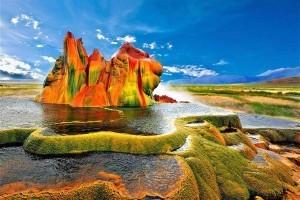
75 places so colorful it’s hard to believe they’re real [pics]
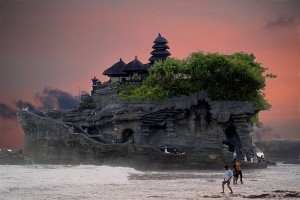
18 scenic places to teach ESL abroad
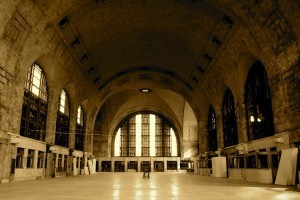
Abandoned train and subway stations of the world [PICs]

4
The Penn Hills Resort, Poconos, USA
This hotel was a popular honeymoon and romantic vacation destination in the 1960s, with its 100 rooms and 500 acres of beautiful Pennsylvanian countryside. In 2009, the owner died at age 102 and the resort closed 2 months later, owing over $1 million in back taxes. It remains unsold and abandoned.
(via)

5
Phone booth graveyard, New York, USA
It's not just places that get abandoned. With the advent of cell phones, New York City ripped out hundreds of phone booths and stored them in an eerie graveyard under some elevated railroad tracks. With no plans to destroy them, presumably the piles of booths will remain where they are until stripped for metal parts.
(via)

6
Olympic Village, Berlin, Germany
The 1936 Summer Olympics, commonly called the "Nazi Olympics," were filmed by Hitler's favorite documentarian, Leni Riefenstahl, to make her controversial film Olympia. After World War II, the village was occupied by the Soviet Army, who used it as a torture base. It has been abandoned since the fall of communism in Germany.
(via)

7
Nara Dreamland, Japan
Inspired by Disneyland, Nara Dreamland opened in 1955 with an almost sarcastically Americana theme that had fountains with statues of Abraham Lincoln and Napoleon. Always underattended, the park closed its doors in 2006 and remains abandoned and untouched to this day.
(via)

8
Maunsell Forts, Thames Estuary, England
These small fortified forts were erected in estuaries of the Thames to protect England against attack from Nazi Germany. After they were decommissioned, several were destroyed by ships running into them, and some were used as pirate radio stations in the 1960s. Paddy Roy Bates claimed Roughs Tower in 1964 and developed the Principality of Sealand, but the other towers remain unoccupied.
(via)

9
Villa di Vecchi, Lake Como, Italy
This fantastically luxurious dream mansion was quickly tainted with misfortune when the count who commissioned it killed himself before its completion, after discovering that his wife had been murdered and mutilated and his daughter was missing. The mansion has been abandoned since the 1940s.
(via)
Intermission

41 places so rad you have to stop driving and get out of the car [PICs]
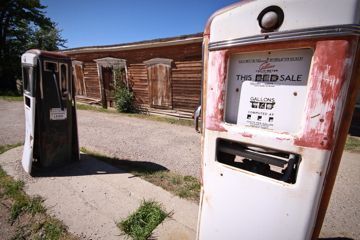
Pompey’s Pillar to St. Mary’s Peak – 1062 images in 2 minutes

Celebrating the sunsets of Seattle

10
La Crypte des Fleurs (pseudonym), Brussels, Belgium
This crypt is made up of three connecting tunnels buried beneath a small chapel in a cemetery in Belgium. The dates of death range from 1885-1978, and the tombs have been apparently untouched for decades.
(via)

11
Power Plant IM, Belgium
This plant in Charleroi, Belgium is said to have begun around the 1930s and was coal-operated. It ceased production in 2006 and is currently set for demolition and overrun with metal thieves.
(via)

12
Berkyn Manor, England
John Milton once lived in this decayed manor, which locals say may be haunted. It has fallen completely into disrepair since its desertion in 1987, and interior stairs, floors, and parts of the roof have collapsed. Trespassers are likely to be arrested if caught.
(via)

13
Buzludzha Monument, Bulgaria
This bizarre flying saucer-shaped monument was built in 1981 to commemmorate secret socialist meetings that were the forerunner to the Bulgarian Communist Party. It is no longer maintained by the government and has been abandoned since 1989.
(via)

14
Eastern State Penitentiary, Philadelphia, USA
Called "the world's first penitentiary," this prison was designed to force criminals closer to God through torture, months in solitary confinement, and enclosure in bitterly cold cellblocks. It closed in 1971 but has been open for tours since 1994. The grounds of the prison contain over 30 different tunnels dug by inmates trying to escape.
(via)

15
Croix Rouge Subway Station, Paris, France
Service to this station stopped in 1939 as preparations for World War II got underway, and never restarted. Passengers can still glimpse the station as they pass through on metro line 10.
(via)
Intermission

Citylapse: New York City and San Diego

Inside the abandoned palace of Penthouse Magazine in Croatia

24 exceptional ice sculptures

16
Kalavantin Durg, India
According to legend, this fort was built around the time of Buddha for a queen named Kalavantin, but nobody really knows for sure. The steps leading up to the fort (which sits at 2000ft elevation) were cut into the rock of the hill. You can see Mumbai from the fort itself.
(via)

17
Muromtzevo Mansion, Muromtzevo, Russia
This elaborate 80-room mansion took 5 years to build, completed in 1889. After the Russian Revolution, its owner donated it to the state to avoid it being looted. It eventually became the Forest College, then was completely abandoned in 1977.
(via)

18
Berliner Bunkerwelten, Berlin, Germany
During the Second World War, the ground under the city of Berlin became rife with more than 1,000 secret bunkers and tunnels. Connected to the surface only with small ventilation shafts, the bunkers eventually fell into disrepair and filled in...there are now only 100 or so, all privately owned.
(via)

19
Noisy Castle, Belgium
Also known as the Miranda Castle, this summer residence for a wealthy Belgian family was seized by Nazis and later converted into a home for children. Left empty since 1991, the castle is full of beautiful architectural details and old furniture.
(via)

20
Moynaq, Uzbekistan
Moynaq used to be a port town, until Soviet irrigation projects drained the Aral Sea's tributaries and left it 150km from the nearest water. The seabed was further polluted with runoff from the cotton industry, which killed many residents. The town is now inhabited only by a few Karakalpak people, who have populated the region for a thousand years.
(via)

21
Cleopatra's Palace, Alexandria, Egypt
A team of marine archaeologists discovered what they believe to be the ruins of the palace of Egypt's most famous queen in 1996. The royal palace was said to have been submerged by a series of cataclysmic earthquakes and tsunamis more than 1600 years ago.
(via)

22
Strip Club, Okayama Mountains, Japan
This abandoned Japanese strip club was euphemistically labelled a "sightseeing theatre." Strip clubs, onsen, and brothels in Japan are often either not open to foreigners or not easy to find unless you speak and read Japanese.
(via)

23
Skellig Michael, Ireland
A Unesco World Heritage Site, the remote island monastery has been abandoned since the 12th century, when the monks relocated to the mainland. The island was inhabited for 600 years, and is home to a number of beehive huts, two oratories, a church, stone terraces, and meters of stone steps.
(via)

24
Abandoned apartment, Paris, France
Madame de Florian fled Paris in World War II, but left her apartment completely intact, and continued paying the rent on it for 70 years. After her death, an auctioneer entered the space and found an eerie collection of hairbrushes, gilt furniture, taxidermy, and a painting that eventually sold for 2.1 million euros.
(via)

25
Chaiten, Chile
In 2008, the Chaiten Volcano in Northern Patagonia erupted after being dormant for 9,000 years. A volcanic lahar caused a nearby river to divert its course, and the town at the volcano's base was destroyed. In 2011, the president of Chile announced plans to rebuild on the original location.
(via)
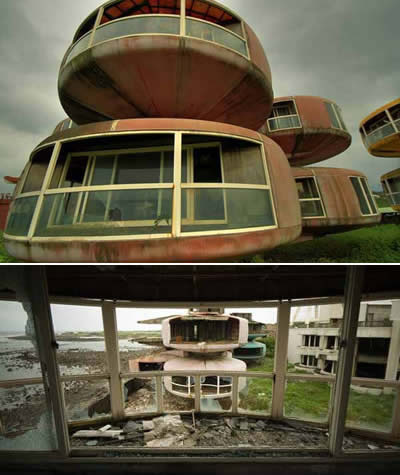
26
San Zhi, Taiwan
This futuristic pod village was supposed to be a resort for the rich, but construction was halted before completion after numerous fatal accidents led to reports the site was haunted. There are no named architects to the project and the government of Taiwan, who originally commissioned the project, have disavowed all knowledge of it.
(via)

27
MS World Discoverer, Roderick Bay, Nggela Islands
This cruise ship was built in 1974 specifically for polar voyages, and had a double-hulled construction to protect it against collisions with ice. In 2000, however, the ship hit an uncharted rock in the Solomon Islands and all passengers had to be evacuated. The captain then steered it into Roderick Bay, where it has remained grounded ever since.
(via)

28
Buffalo Central Terminal, Buffalo, NY, USA
This 17-story art deco building was Buffalo's main railway terminal for 50 years, finally closing in 1979. After it closed, it was extensively looted and vandalized, and some said the only thing blocking it from demolition was the cost. In 1997, the Central Terminal Restoration Corporation purchased the derelict building for $1 and is currently restoring it.
(via)
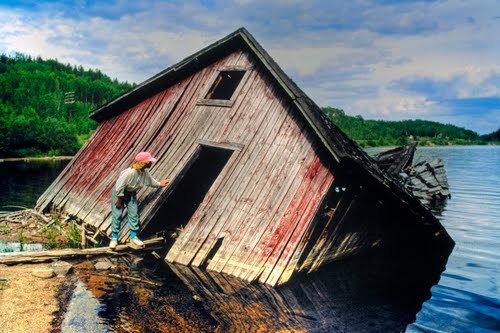
29
Nicholson, Ontario, Canada
300km north of Sault Ste Marie, this tiny Ontario town is only accessible by boat or on foot over the railroad tracks, a 2.5-hour walk. A deserted lumber town, it displays old logging equipment, and many well-preserved abandoned buildings, including a church and a school.
(via)

30
Spinalonga Island, Greece
From 1903 to 1957, Spinalonga was used as a leper colony, and was one of the last leper colonies in Europe. The last inhabitant of the island was a priest determined to uphold a tradition of the Greek Orthodox Church where buried people must be commemorated at 5-year intervals; he finally left in 1962.
(via)

31
Oradour-sur-Glane, France
During World War II, German soldiers mistakenly invaded this small French town, intending to target nearby Oradour-sur-Vayres. 642 of the village's residents were massacred in punishment for the French Resistance, and the village was razed by the Germans. It has stood empty since then, and acts as a memorial to the dead.
(via)

32
Salton Sea Beach, California, USA
Salton Sea Beach was flooded in 1973 by highly saline water from the nearby Salton Sea, an accidental inland ocean created when the Colorado River poured through salt flats in 1905. Residents left most of their belongings and moved elsewhere; you can still find alarm clocks, dolls, and LPs embedded in the inches-thick crust of salt that covers every surface.
(via)

33
Talisay Mansion, Talisay City, Philippines
This enormous mansion in Talisay City, Philippines was built by a sugar baron in honor of his 11th wife. In World War II, Filipino guerillas employed by the US Armed Forces set the building on fire. It burned for several days and sat empty for a long time, until it was remade into a restaurant.
(via)

34
Pyramid of Tirana, Tirana, Albania
This bizarre pyramid was built as a monument to an Albanian leader who kept Stalin's dreams alive long after the Russian dictator died. As national attitudes shifted, the space converted to a convention centre in 1991, then to a military staging centre, then a television station. It has since been looted for building materials and covered in graffiti, and the government is campaigning for its demolition.
(via)

35
Onverwacht, Suriname
This abandoned station was built to transport gold miners into and out of the interior of Suriname. The line went out of use in the 1980s and the train cars were left to decay.
()

36
South Fremantle Power Station, Fremantle, Australia
The South Fremantle Power Station opened in 1951 and employed 250 people at its peak. After technological advances made it uneconomical, it closed in 1985 and has since become a museum of constantly changing graffiti, broken glass, and old spray paint cans.
(via)

37
Whittingham Asylum, Lancashire, England
Whittingham Asylum was once the largest mental institution in Britain; founded in 1869, it had its own farms, telephone exchange, post office, orchestra, and even a brewery. After being taken over by the military during World War II, the asylum slowly declined and finally closed in 1995 after allegations of abuse against patients.
(via)
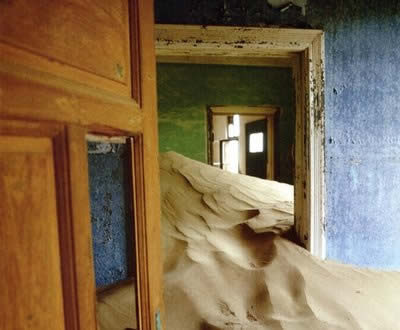
38
Kolmanskop, Namibia
In 1908, the port of Lueditz was inundated with people rushing into the Namib Desert to make a fortune on diamonds. The town of Kolmanskop enjoyed a boom until the drop in diamond sales after World War I, and the town was deserted in the 1950s...to be reclaimed by the desert.
(via)

39
Slab City, CA
Only a short drive from Salton Sea Beach, Slab City sits outside Niland in a remote area of the California desert. Once a World War II Marine barracks, the camp was abandoned, then razed, leaving only concrete slabs. Currently it is used by snowbirds, drifters, and off-the-grid enthusiasts as a temporary city and gathering place.
(via)

40
Michigan Central Station, Detroit, USA
Detroit is notorious for being half-abandoned, half-revitalised. While some sections of the city are deserted, full of condemned buildings and collapsing schoolhouses, other parts are slowly revitalising as current residents repair their homes and new residents are offered free houses.
(via)

41
Tillamook Rock Lighthouse, Oregon Coast, USA
This lighthouse was officially lit in 1881 and quickly nicknamed Terrible Tilly due to the hazardous commute lighthouse keepers faced from the mainland. It was damaged extensively by storms and eventually decommissioned in the 1950s. It is now privately owned and accessible only by helicopter.
(via)

42
Stella Artois Brewery, Leuven, Belgium
This particular brewery was replaced by a newer and more efficient facility nearby. Looters stripped much of the copper and metal fixtures, which led to all entrances being sealed. Stella Artois remains a popular pilsner.
(

43
Moonhole, Bequia, Grenadines
Bequia is full of stone holiday homes that can be rented, but the Moonhole, so called because the setting moon shines through the rock formation archway, is not up for grabs. The danger of falling rocks from above has made it uninhabitable, and it is currently closed to entry.
(via)

44
Harperbury Hospital, Hertfordshire, England
(via)

45
Craco, Italy
The summit where Comune di Craco sits may have been inhabited as early as the 8th century. By the mid-1950s, seismic activity put the town in danger, and a series of landslides forced the entire population to relocate in 1963. It has since been
The post 45 eerily beautiful abandoned places [pics] appeared first on Matador Network.

February 18, 2014
The gentrification of Old Tbilisi

All photos: Author
Tourism is big business. Big enough to change culture itself. Where there is a buck to be made, it will be made — as fast and as efficiently as possible. The architects of the capitalist world we live in are unstoppable, and cashed-up tourists are soft targets in this game.
And so, Old Tbilisi, the historic quarter at the very heart of the modern capital city of Georgia, is being changed beyond recognition. Transforming from a beautifully decaying authenticity, Old Tbilisi is becoming a shiny and hollow scintillation, filled with ever more opportunities to load up on cheap souvenirs and imported beer. Is this the birth of yet another tourist trap?
Old Tbilisi is a centrally located neighbourhood, containing an assorted mix of buildings from as early as the 5th century. Today, the bulk of the structures are an eclectic collection from the 1800s. Much like the nation of Georgia, the area has seen a long and at times tumultuous history. As a result of earthquakes, invasions, and a geographical location within the cradle of various historical empires, Old Tbilisi is completely unique — a diverse, centuries-old urban layering, holding extreme importance to the nation. Worldwide, the priority of preserving the district has been recognised by many independent international bodies. However, over the last decade or so, its future has been in grave danger.

Typical street scene in Old Tbilisi, Georgia.

Eclectic architecture and palette of Old Tbilisi homes.

Doorway, Old Tbilisi house.

Decaying church in Old Tbilisi. Internally, the structure was braced with steel girders, and was too dangerous to enter.

Around every corner, decay. Old Tbilisi.

Irresistible to tourists, for now. Old Tbilisi.

Crumbling facade, typical of Old Tbilisi.

Streets of Old Tbilisi.

Going, going, gone. Old Tbilisi.
There are complex issues to consider in Old Tbilisi — not the least of which are the slum-like conditions that many residents here live with. Many of the structures are now uninhabitable and beyond repair. Despite the obvious bewitching appeal of the streets, Old Tbilisi could be holistically described as both “enchanting, and dismal.” It would appear wrong to be so nostalgically driven as to state that nothing should change in Old Tbilisi. But it’s important to remember that these neighbourhoods are special, unique, and, unfortunately, endangered. In an ideal world, Old Tbilisi is a neighbourhood that retains its authenticity as well as quality of life for its residents.
Currently, older buildings are being replaced with architectural innovations in steel and glass. Disney-esque facadism is taking over — with Irish bars and “authentic” Soviet-themed restaurants housed in restored buildings that maintain little of the original charm. And no doubt, Old Tbilisi will be promoted by the local government as a tourism success story. A new and authentic neighbourhood narrative will be manufactured. Residents will be relocated. Corner stores will be replaced with souvenir shops. International franchises will move in. “Boutique Tbilisi hotels” will become an increasingly popular Google search keyword. Developers and entrepreneurs will be happy. The gentrified grand scheme will be complete, and it will be on to the next target. Viva, capitalism.
I was told that I needed to get to Georgia before it changed. It’s something you get told a lot in the travel world. But in the case of Tbilisi’s old town, it’s judicious advice. In 2013, only small pockets of the “original” old town remain. These unprofitable enclaves will soon cease to exist within Old Tbilisi, as the value of the location is unlocked. But, for now, the twisted back streets filled with gracious decaying buildings are, in my opinion, the number one tourist attraction in town. [image error]
This post was originally published at Yomadic and is reprinted here with permission.
The post Old Tbilisi, Georgia: Decaying beauty, or birth of a tourist trap? appeared first on Matador Network.

800-pound snowball crashes into college dorm in Portland, Oregon

(Via)
RECENTLY, PORTLAND EXPERIENCED snow-maggeddon; 12-inches of snow fell, closing stores and roads across the city that were not prepared to deal with the weather. It was awesome though, because it turned my day off from work into a five-day staycation.
A mere mile away from my current apartment however, some Reed College students saw this as an opportunity to finally build the largest snowball the campus had ever seen. The two math majors managed to scoop-and-pat their way to an 800-pound, 40-inch wide snow-boulder, before losing control of it. It rolled down a hill, and slammed into an on-campus Reed College Apartment, ripping one wall off the studs, and costing nearly $3,000 in damages.

(Via)

(Via)
When I went to Reed, I actually lived in the apartment immediately above that one, and the walls are so thin I can guarantee you everyone in the whole complex felt it when that snowball hit – just like how everyone knew when I was watching movies instead of working, when my neighbors were having weird sex, or when the dude below me was purifying his latest batch of mescaline. 
The post 800-pound snowball crashes into college dorm in Portland, Oregon appeared first on Matador Network.

Food Recovery Network documentary
“AMERICANS WASTE 33 million tons of food each year.” Staggering, but not surprising. I’m sure, per capita, that the numbers aren’t much, if at all, better in Canada. One of the grocery stores where I live used to have a bin out back where lots of people went dumpster diving, recovering perfectly good food (they would throw things like boxes of granola bars out because they were dented). Unfortunately they went out of business; the remaining grocery stores lock up their bins and truck out the waste nightly making sure no one can get at their discarded food.
Sometimes when governments are slow to act to help their people you need to take matters into your own hands. That’s exactly what this group of college students, led by Ben Simon who founded the Food Recovery Network, are doing. As of today, since it was founded in September 2011, they’ve recovered and donated 245,284 pounds of food.
So many people going hungry while there’s so much abundance in the community has to be one of the biggest shames of our society. Find out how you can get involved on their website. 
The post There are starving people amidst an abundance of food, this is how we can stop it appeared first on Matador Network.

When freelance clients don't pay

Photo: Tim McFarlane
Paying people to do stuff has never been easier or more precarious than it is today. If there’s “stuff” you can do, there’s someone out there who wants to pay you to do it via the internet, and probably other people still who want to tell you they’ll pay you to do it and then not pay you to do it once you’ve done it.
If you made it through that labyrinthine sentence and are still with me, you’ve probably already been swindled by someone and should probably take some of these accountability actions the internet can uniquely facilitate.
Give it some time.
I’ve had plenty of clients who’ve given me seemingly bullshit excuses for not paying me on time (“I’ve been on vacation [for two months],” “We fired our old accounts manager [and the three after],” “I had a problem with my credit card [and can’t use PayPal],” “What? Payment never went through?”). And surprisingly, they’re usually genuine. Or at least the clients are once they realize I’m not pro pro bono.
The fact is most people who hire you really do intend to pay you, and sometimes things get in the way. People often hire freelancers because they’re too busy to do the jobs themselves, and it’s easy to forget about the formalities. Give it a week, send a reminder, and go from there.
Communicate regularly, not constantly.
Don’t just assume from the get-go that an overdue payment means you’re getting scammed. After the first email, send another in a few days, and just keep stringing along every few days thereafter and gauge the reaction (if any). If there really was an honest mistake, you don’t want to come across as overbearing and untrusting and risk losing repeat work if there really was a good reason you weren’t paid on time. So hold off on the hourly Facebook wall death threats until you’re certain they’re pulling a quick one.
Skype attack.
It helps to do this from the start, but if you missed your chance, you can usually still finagle a Skype request acceptance if you know the client’s name. If the client does accept, you have instant proof that he/she is actively online and definitely still alive, thus destroying the all-too-common excuse of “Couldn’t pay — spontaneously combusted.”
People can ignore emails and claim they never got them. They cannot, however, claim they never got your Skype messages. Especially considering most clients I’ve talked to on Skype are online just about all day every day.
Use BEACON’s Pay Me Please.
BEACON is a stellar new subscription-based news / essay / content outlet that’s trying to change the online media game by having subscribers pay their writers directly for access to their content. Pay Me Please is a service they put on with journalist, freelancer, activist, and all-around badass Iona Craig, on which writers can call out media outlets that are shafting them.
It tracks the payment amount (some in the four figures), how late it is (some well over a year), and who’s doing the non-paying (including the likes of BBC). While this isn’t actually an action-taking process (you’d have to pay someone if you didn’t want to take action yourself), it is a sort of “public shaming” means and support group, as well as a way of keeping track of your pending payments in case you’re not into the whole spreadsheet thing.
Bonus tip: It may be sort of like scouting for a steady girlfriend / boyfriend at Sexaholics Anonymous, but this is also a great resource to find places that (theoretically) pay for content.
Go social.
When you’re writing for a media outlet, there’s always a risk of not getting paid until / unless they send you a contract (and even then it can be tentative). Freelancer websites are supposed to remedy this. But one of the problems with getting freelance work on a site like oDesk or Elance is that some people are good enough at being bad people that they can still cheat the system if contractors aren’t careful, and in that event you’re typically not left with any of the client’s contact info except the site’s internal messaging service.
However, there’s good chance you will have a name. And a name is probably all you’ll need to find this person on any number of the various social media outlets (assuming it’s his/her real name). It’s not likely this person will accept a friend request from the person he/she just ripped off for you to start posting selfies of your middle finger or jpg’s of a decapitated horse head, but you can attempt to reach out via private message. Twitter is great for this, as you can still tweet at anyone or mention them without their say-so and can even prove they’re active by following their tweets.
Consider progressive aggression.
If you do manage to get a method of contact in place with no response, payment is late by several weeks or longer, and your benefit of the doubt has run dry, make threats to report the person to admins (if on a freelancer website), to badmouth them on social media, to report them to an attorney, to report them to the Freelancers Union, to the BBB, to the CIA, to the SEC, to the JAP, to the QVC, to whoever the hell you think will make an impression.
My own worst experience with this came over the course of about a year. Even though I eventually got pretty heated with my messages, they progressed very slowly from gentle nudge to passive-aggressive questioning to I’m-warning-you finger shaking first. After no response for about four months, I’d haphazardly throw out some half-baked threat about contacting the BBB (which it turns out I couldn’t actually do anyway) now and then until someone finally emailed me out of nowhere and set up a PayPal transfer and explained the unfortunate mishap.
And sometimes that’s really all it is. But you need communication to know that. Though the impersonality and general lack of accountability that the web affords dishonest (or even just scatterbrained) people enables them to easily rip honest people off, notice that all these solutions involve internet communication. We’re able to go Zoe Barnes and make public our private betrayals, we’re able to enact our own social vigilantism and enforce accountability to indefinite extents. Ultimately the internet is both the problem and the solution to its own problem. [image error]
The post What to do as a freelancer when clients don’t pay appeared first on Matador Network.

We are naturally programmed to cheat, according to this animation
AS AN ANTHROPOLOGY student, I spent a lot of time studying animal and human behavior regarding sex, and emotional activity. There is a lot to say on how the concept of monogamy came about (in the early days, it had more to do with women being seen as “property,” than it’s current-day romantic connotation), but the stark truth is, a majority of animals are not hard-wired to mate with one partner forever.
Before you go out and start sleeping around though, keep in mind — when it comes to partnership, humans take more into consideration than just copulating for better genetic variety, or the probability that their “seed” will be “sown.” We are emotional, and these emotions direct our actions – if we’re happy in a relationship, we tend to stick with our partner. If we’re upset, or feeling unloved, our emotions push us in different directions. It’s not all simple as that, but it gives you a general idea of why we do, what we do (and with whom).
This video also gives new meaning to Cole Porter’s lyrics, “Birds do it, bees do it, even educated fleas do it…” 
The post We are naturally programmed to cheat, according to this animation appeared first on Matador Network.

White South Africa is small

Photo: Sandra Maytham-Bailey
I must be giving off bad vibes, because I’m on a Paris to Durban flight full of white Southern Africans and it still takes the woman sitting next to me five gin and tonics before she feels bold enough to talk to me.
By the time the captain announces our descent, she’s in full swing. Her new life in Wales, her son, his girlfriend…. Her eyelashes are heavy with the mascara she’s just reapplied, and I find myself mimicking her wide eyes as I listen.
She can’t tell her life story to the couple to her left. It turns out they’re the long lost friends of her father. They already know it.
“What a small world, hey?” she says, looking around for anyone willing to hear about the coincidental reunion.
Yes, I think, White South Africa is small.
By the time our plane touches down on the tarmac at King Shaka International Airport, people are leaning over the backs of their chairs, discussing which friends they have in common, where they’re going to spend Christmas, and who’s going to whose wedding.
We’ve taxied into place. The plane’s been stationary for at least ten minutes now. Bent backs and strained arms under the weight of our bags as we all wait for the doors to open. Our little community has grown quiet. The queue doesn’t budge. All we want is to be out in that humid Durban air.
I’m reminded why all the chummy small talk makes me claustrophobic. It’s only chummy because we’re united by colour.
Just when our tired silence becomes too much to bear, my mascara neighbour leans forward to the man she was chatting to earlier and says in a thick pastiche of a black South African accent, “There seems to be a problem with the door.”
He sniggers and sends a ripple through the cluster of passengers that overheard. All the warmth drains away. Unsurprised eyes and shaking heads. The words “black incompetence” drift unspoken on the air, and I’m reminded why all the chummy small talk makes me claustrophobic. It’s only chummy because we’re united by colour. The sealed door of our insulated community has barely been opened and already white South Africa is cringing in the face of black South Africa.
* * *
It’s been two weeks and now I’m in a car driving through the green hills of the Eastern Cape, where Nguni cattle graze and where thunderstorms eat at the rivers and make them deep and angry with erosion.
Today the new South Africa is a glinting skyline of solar water heaters over a lean-to shantytown. Today, the new South Africa is all about the silver linings.
The dorps slip by. Maclear, Ugie, Indwe, and then I see a dusty cemetery with skinny gum trees and yellow grass. All the marble gravestones are caged and padlocked against theft. They drift past the window and no one says a thing. That quiet vision of peaceless rest pulls me back from my lighthearted hope and says, “This new South Africa is a whole new beast.”
* * *
The smooth green of the Eastern Cape turns to flat dust. In the Karoo, the finger-long thorns of dead acacias are bleached bone white by the sun. The red and orange cliffs of Meiringspoort rise up out of the desert in time for lunch. It’s like weaving through the molars of a giant. You have to keep your head low to see the mountaintops singing in the bright light.
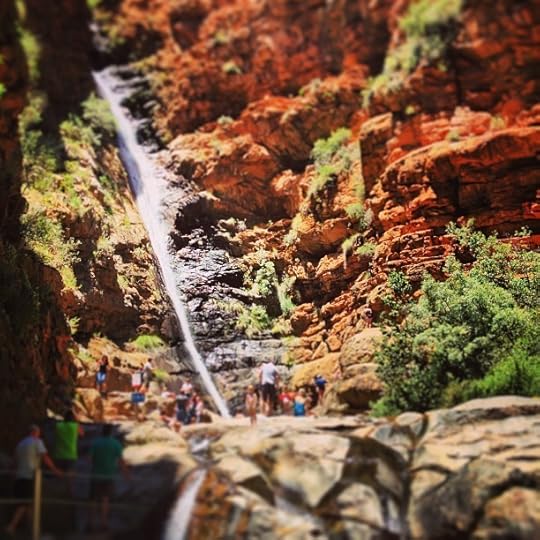
Photo: Werner Vermaak
All the cars that have been making their way through the landscape alone have parked together in a concentrated hub at the riverbed.
“Shall we just turn around and keep going?” says Ma.
Crowds in beautiful places are her worst, but it’s too hot and we all want to swim in the waterfall. One by one the plug of people drips into single file, and we scramble over the rocks in loose flip-flops and bright swimming trunks. There are thick-necked, hairy-bellied whites. There are slinky, urban, cool-cat blacks. Slim-wristed Indian girls and teeming families of Cape-Coloured kids with gold earrings and scabby knees.
The only thing we all have in common is we’re all middle class enough to be on holiday, and just middle class enough not to turn our noses up at somewhere free.
The waterfall is a high ribbon of white water. It’s drilled a deep black pool into the rock below. Kids patter about in the blue shallows further down, but the real action is happening up at the main falls.
I wend my way up through the crowds and try to ignore the smell of piss coming from the rocky alcoves to my left. There are small ledges high above the pool that you can jump from. The rotund body of an Afrikaaner man waits above us, feet on the edge, stony faced with virility. A buzz of chatter erupts behind me as a black 20-something splits from his group and starts to climb up the cliff. He’s climbing fast, as if going any slower would give him time to think twice. The ledge is small and the two bodies vie for space. The young man whips off his t-shirt, fishes out his cellphone for a quick selfie, removes his cap, and hands the neatly folded pile to the Afrikaaner. His new iPhone crowns the pile. In a place where gravestones get stolen, this is trust. Could it even be community?
The young man says a short prayer and throws himself off the edge. [image error]
The post White South Africa is small appeared first on Matador Network.

What's happening in Venezuela [vid]
AMONGST THE Olympic excitement and the standard Facebook drivel spilling down my feed, I came across this video and a plea from a good friend in Caracas, Venezuela. It stopped me in my tracks, and the video blew me away — not only because of what’s happening in Venezuela right now, but the fact that I’d heard so little about it in the American media.
From my friend in Caracas:
PLEASE TO ALL MY FRIENDS THAT KNOW ME AROUND THE WORLD, MOSTLY MY FRIENDS IN USA AND THE REST IN THE WORLD! THIS IS A MUST WATCH VIDEO OF WHAT IS REALLY GOING ON IN MY BEAUTIFUL LOVELY COUNTRY! MY PEOPLE ARE FIGHTING AND DYING TO GET FREEDOM AND FOOD…
The post You need to see what’s happening in Venezuela right now [vid] appeared first on Matador Network.

10 reasons to visit the Guianas
French Guiana (or Guyane), Suriname (previously Dutch Guiana), and Guyana (until 1966, British Guiana) are undoubtedly the three countries you fail to come up with when trying to fill in a map of South America.
Situated along the northern coast, between Brazil and Venezuela, this obscure region shares little with the rest of the continent. These nations were never conquered by the Spanish or Portuguese, and thus the typical Romance languages you associate with South America aren’t spoken here (they speak French, Dutch, and English, respectively). Culturally, they’re closer to the Caribbean than the rest of South America.
Given the diminutive size of the Guianas, my partner and I expected to cross the region in a matter of weeks. Instead, we stayed a year and a half, and the following experiences were only some of the reasons we had a hard time finally leaving.
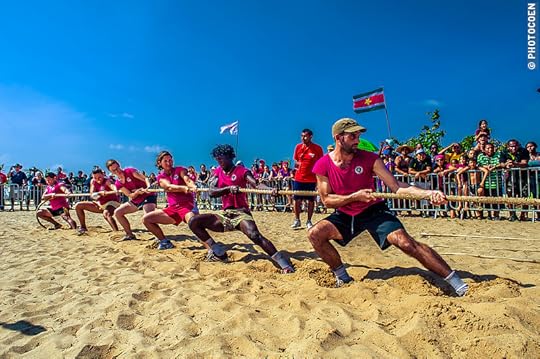
1
Watching, or participating in, traditional Kali'na games (French Guiana)
About 10 years ago, the Kali'nas, one of French Guiana's indigenous groups, started organizing annual games to challenge each other in traditional contests. Nowadays, various indigenous groups, French Guyanese, French, and even international teams participate in the weekend-long, adrenaline-filled events. It's quite a spectacle watching people climbing coconut trees, throwing spears, pulling a fishing boat ashore, and running while carrying a 20-kilo tree trunk. Who knows, perhaps you can join a team.
All photos: Coen Wubbels

2
Seeing sloths in the wild (French Guiana)
In some parts of South America sloths are still hunted for their meat, and many die in deforestation projects—moving at 400 meters per hour, they aren't fast enough to escape from the forest when the bulldozing starts. French Guiana, however, has a relatively strict policy on protecting sloths, and as a result it's the best place in South America to see them in the wild. In particular, the Rorota Trail just outside Cayenne is a well-known and accessible habitat.

3
Watching winti rituals (Suriname)
During colonial times, many slaves in Suriname fled from plantations and hid in the rainforest. Their descendants are called Maroons. Many still live in the forest, in . While many have converted to Christianity, ancient traditions and rituals are still very much a part of their lives.
The community of Pikin Slee is especially known for its traditional way of life. This is the place to see winti rituals such as dancing in fire and over burning coals, and unique celebrations that are part of their burial rites, which include dancing and the deceased's family throwing gifts to the public.
Intermission
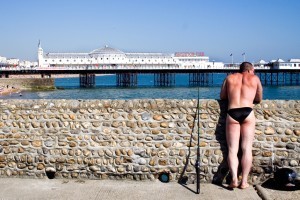
13 moments of culture shock for the first-time American traveler

21 reasons Portland is the ultimate college town
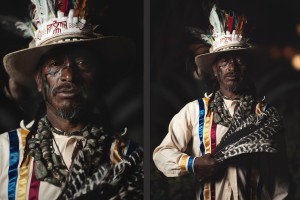
Unearthing the temple: Portraits of the Mazahua and Mixteca at Mexico City’s Templo Mayor

4
Visiting Europe's Spaceport to watch a rocket launch (French Guiana)
Europe has a spaceport in South America? Yep. French Guiana isn't an independent country, but rather an overseas department of France. Rocket parts and other equipment are shipped in from all over the world, and assembly happens at the launch site in Kourou. There's an extensive museum about the space center's history and projects, and you can visit the site on a three-hour guided bus tour.
When rockets launch (there are some 5 to 10 per year), you can watch them from pretty much anywhere along the coast, or sign up for a spaceport bus that will take you to one of the hills surrounding the site for up-close observation.

5
Celebrating New Year's Eve during the day (Suriname)
The most important part of Suriname's New Year's Eve is celebrated during the day. Around noon, Paramaribo's center is packed when a 20-minute roar starts as a 2km line of firecrackers is lit. Bring earplugs, and your camera. This is the start of an binge of drinking and dancing in the street.

6
Retracing Papillon's steps in France's former penal colony (French Guiana)
For a long time, there was widespread debate as to whether Papillon, written by Henri Charrière, was autobiographic or not. Archives say no, but Charrière was a prisoner here -- you'll find his nickname, Papillon, carved into a wall of one of the cells.
It's assumed that his story is a combination of his and other prisoners' experiences in the penal colony that operated here for over 100 years (1850-1953). There are two places of particular interest: the transportation camp in Saint Laurent de Maroni, where the prisoners arrived from France, and the impressive ruins in the tropical forest of the famous Devil's Island / Îles du Salut.

7
Participating in the prestigious 4-day Savanna Rally (Suriname)
In early November, some 100 teams—national and international—set out to conquer Suriname's savanna. Next to the Dakar Rally, it's South America's biggest off-roading spectacle. Foreigners can rent an equipped 4WD for the event. Signing up is a way to be part of a fantastic Surinamese happening, and to see an extraordinary part of the country's geography, one that is generally omitted from the tourist trail. For information, contact SARK.
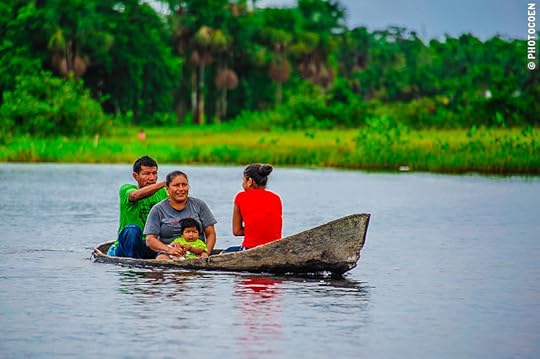
8
Canoeing with the Awarak (Guyana)
The Awarak are an indigenous group that lives in the rainforest of west Guyana and can only be reached by boat. They've lost many of their traditions, as well as their language, due to the pressure exerted on them by missionaries to learn English. However, some traditions have remained, like canoeing through savanna-like wetlands—some of the most peaceful places you'll find anywhere.

9
Driving on the longest floating steel bridge in the world (Guyana)
One of the first things Guyanese will mention to visitors is 'their' bridge. They take immense pride in the 1851-meter Demerara Harbour Bridge, which is a chain of steel pontoons that are kept in place with cables. It crosses the Demerara River, was constructed in the 1970s, and is used daily by some 14,000 vehicles.

10
Exploring a goldmining region to try your luck (Guyana)
Whereas in French Guiana and Suriname we were discouraged from going into the interior, we were welcomed into Mahdia, Guyana's largest gold mining region. As the business here is largely legalized, it's under supervision by police and environmental organizations. We felt safe and welcome.
The following example characterized the good vibes: As a guard guided us through the latest "shout"—a place where a new gold vein has been discovered, which will potentially bring in millions—outsiders were sweeping the same area with metal detectors. When we commented on this, our guard said, "No problem. There's enough. This is how we all started, so we cut them a little slack." If you have the inclination to search for gold, this may be the place to start. [image error]
The post 10 experiences you can only have in the Guianas appeared first on Matador Network.

59 questions to improve your writing

Photo: Christian Bucad
Editor’s note: This is the first part of a 5-part series, Transforming your travel writing.
1. What is the editor’s first name?
2. Who are her associate editors?
3. Which of these people are you emailing and why?
4. Is your pitch scannable / actionable in 15 seconds or less?
5. Is a single URL of your other work readily available?
6. How does your story or proposal support / advance the publication’s brand mission?
7. Is this support evident right in the title of the story?
8. Has this same topic / angle already been covered?
9. If so, does it play off an already successful concept in a new way?
10. Are precise place-names, times, dates, used?
11. Is there precise, correct terminology in the descriptions (architectural terms, music, gastronomy, geology, weather)?
12. Are characters introduced in ways that create emotional resonance?
13. Are characters’ proper names provided?
14. Are relationships between characters and the narrator made clear?
15. Is it clear why the narrator is traveling through this place–is there a clear “purpose”?
16. Have you as the author in any way appropriated or confused your subjects’ struggles / challenges / stories as your own?
17. If investigating a certain issue (environmental, social) have you actually spoken to people affected by the issue?
18. If investigating a certain issue (environmental, social) have you actually spoken to people with a vested interest in companies / political parties / etc. connected to the issue?
19. Are you in any way “speaking for” a people or culture you’re not actually from?
20. What have you left out of your story and why?
21. Who are you actually writing the story for?
22. How can you make the emotions you portray in your story more accurately reflect the emotions you actually felt during the experience?
23. Are there material connections (financial arrangements, etc) to elements in your story that you don’t reveal?
24. What would the reactions be of the characters and / or subject of your story, if they were to read it?
25. What does the landscape in your story sound like?
26. What are the natural indicators of the season, the time of year?
27. What phase was the moon in?
28. What constellations were present?
29. What did the place (and other characters) smell like?
30. How fluent are you in the language spoken where you story took place, and how did operating in a second (or 3rd, 4th, etc.) language influence what you interpreted from the events?
31. What memories or associations were triggered in your experience and how are these woven into the narrative?
32. What is the tense and why have you chosen it?
33. What is the POV and why have you chosen it?
34. Does your story answer the 5Ws (who what where when why) about the subject and narrator within the first few paragraphs?
35. Do you use words and expressions that are completely unlike how you’d speak in real life?
36. Is the story about something you that matters to you?
37. What local terminology did you learn for elements of the culture / land / people that are not translatable in English, and how have you presented them in the story?
38. Does your story contain dialogue?
39. Is the dialogue dynamic or “transactional”–in other words, does it contain an emotional exchange, reversal, argument, agreement, etc.–or is it static?
40. What is the subject of your story?
41. What is the subtext of your story?
42. Can you cut the first paragraph and start at the second?
43. Can you cut the last few paragraphs and find a stronger ending?
44. Are you forcing a conclusion on readers or allowing the space for different interpretations to emerge?
45. What role does texture play in your story?
46. What role does taste play in your story?
47. What was your motivation for writing the story?
48. What can you cut from the middle of the story and have it flow faster?
49. Could you rearrange the sequence of events so its not linear but some other chronology?
50. Did you include (or source) imagery for your story?
51. Are the images accompanied by captions?
52. Do the captions tell the editor more than what she or he can already grasp just by looking at the photos?
53. How did you approach people for information during your travels?
54. Were you invited back?
55. What were the political / cultural events / conversations taking place while you were traveling and how doe these figure into the story?
56. What was the quality of the light where you were, and how is this represented in your story?
57. What was the hardest part of writing this story and why?
58. What questions are still unanswered after writing this story?
59. What are you promising the reader (beginning with the editor) in your title? 
Editor’s note: This lesson is excerpted from new and forthcoming curricula at MatadorU’s Travel Writing program.
The post 59 questions before sending your writing to an editor appeared first on Matador Network.

Matador Network's Blog
- Matador Network's profile
- 6 followers




